Mark Sisson's Blog, page 275
January 9, 2015
Keep Moving: Change Is a Process
It’s Friday, everyone! And that means another Primal Blueprint Real Life Story from a Mark’s Daily Apple reader. If you have your own success story and would like to share it with me and the Mark’s Daily Apple community please contact me here. I’ll continue to publish these each Friday as long as they keep coming in. Thank you for reading!
 In December 2010, after 18 years of being employed at the same company, I lost my job. During my tenure with the company I never gave much thought to the negative impacts of stress and my eating habits. But suddenly I was unemployed, overweight at 322 pounds, and faced with the prospect of starting over at 39 years old. For mine and my family’s sake I needed to make some changes—not just in jobs or careers, but changes in every facet of my life. In February of the following year, after an unusually hard night of partying, a metaphorical switch flipped in my head after looking at the previous night’s pictures. It was time to act and the first step in my transformation was to take control of my health. I had been an active person prior to my management career but never really considered how diet and fitness go hand in hand. I went online, using a BMR calculator and determining how many calories I burned in a day. I researched how macronutrients created different metabolic responses in the body.
In December 2010, after 18 years of being employed at the same company, I lost my job. During my tenure with the company I never gave much thought to the negative impacts of stress and my eating habits. But suddenly I was unemployed, overweight at 322 pounds, and faced with the prospect of starting over at 39 years old. For mine and my family’s sake I needed to make some changes—not just in jobs or careers, but changes in every facet of my life. In February of the following year, after an unusually hard night of partying, a metaphorical switch flipped in my head after looking at the previous night’s pictures. It was time to act and the first step in my transformation was to take control of my health. I had been an active person prior to my management career but never really considered how diet and fitness go hand in hand. I went online, using a BMR calculator and determining how many calories I burned in a day. I researched how macronutrients created different metabolic responses in the body.
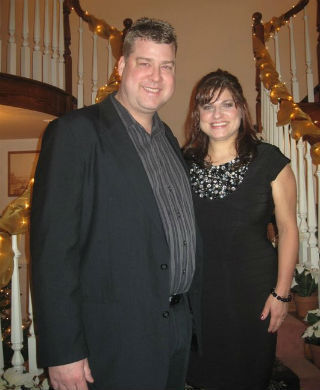 Based on this research, I discovered that keeping carbs low was the best way to burn body fat. I also understood that in order to keep carbs low I would have to eliminate grains from my diet. I then constructed an eating plan around creating a caloric deficit and started to work out again. I was inspired and determined, working out six days a week and sticking to my eating plan. I tracked my calories using an online app. Over the next 12 months I lost 86 pounds, and while I was proud of this achievement, I wanted more.
Based on this research, I discovered that keeping carbs low was the best way to burn body fat. I also understood that in order to keep carbs low I would have to eliminate grains from my diet. I then constructed an eating plan around creating a caloric deficit and started to work out again. I was inspired and determined, working out six days a week and sticking to my eating plan. I tracked my calories using an online app. Over the next 12 months I lost 86 pounds, and while I was proud of this achievement, I wanted more.
Over the next year I concentrated on body composition, building lean mass and dropping body fat. I did my first “bulking” period from October 2012 to January 2013 by increasing calories to reflect a surplus, but my mistake was that I increased carb intake (mostly from grains) over that period. The result was a 37 pound gain with substantial body fat gain. My second “bulking” period ran from October 2013 to February 2014, this time using Primal eating methodology and keeping carbs low. This resulted in a 14 pound gain with little body fat gain.
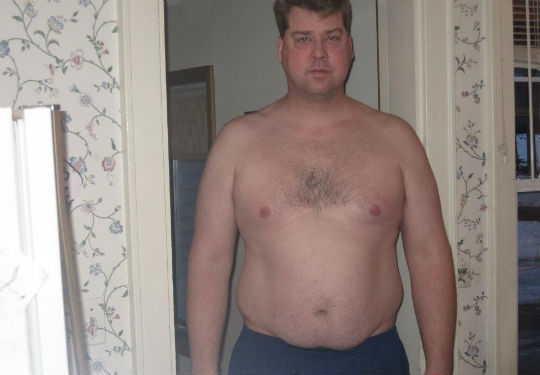
![GetAttachment[2]](https://i.gr-assets.com/images/S/compressed.photo.goodreads.com/hostedimages/1420956160i/13297702.jpg) I first read The Primal Blueprint in early 2013 but had been a follower of MDA since the fall of 2012. The fundamentals of the Blueprint appealed to me. Less time in the gym, playing more, sprinting once in a while, eating real wholesome health-protective foods and getting lots of rest: this was something I could embrace that was easily sustainable. I allow myself an indulgence now and then. Just yesterday, I ate an entire pizza. But today I’m right back to it. I have also incorporated some intermittent fasting and compressed eating windows into my regimen as well. The results speak for themselves and in late July of this year I achieved the 100 pounds lost mark…102 pounds to be exact. I’m leaner and stronger now, working out less, and eating more in terms of calories. At every opportunity I sing the praises of the Primal lifestyle and do convert some people to our Primal ways. But I still encounter many people who are hopelessly mired in the dogma of conventional wisdom. Somehow people just can’t wrap their heads around eliminating grains, eating healthy fats and working out half as much as they’re used to.
I first read The Primal Blueprint in early 2013 but had been a follower of MDA since the fall of 2012. The fundamentals of the Blueprint appealed to me. Less time in the gym, playing more, sprinting once in a while, eating real wholesome health-protective foods and getting lots of rest: this was something I could embrace that was easily sustainable. I allow myself an indulgence now and then. Just yesterday, I ate an entire pizza. But today I’m right back to it. I have also incorporated some intermittent fasting and compressed eating windows into my regimen as well. The results speak for themselves and in late July of this year I achieved the 100 pounds lost mark…102 pounds to be exact. I’m leaner and stronger now, working out less, and eating more in terms of calories. At every opportunity I sing the praises of the Primal lifestyle and do convert some people to our Primal ways. But I still encounter many people who are hopelessly mired in the dogma of conventional wisdom. Somehow people just can’t wrap their heads around eliminating grains, eating healthy fats and working out half as much as they’re used to.
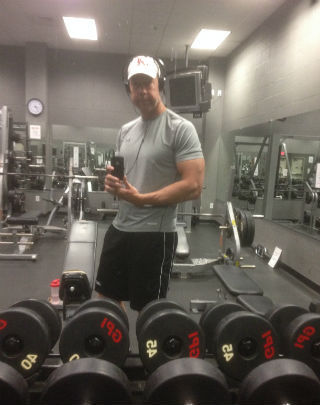 In this same time period I also changed careers, went back to school, and became a certified social studies teacher. I always had an affinity for history so it was a perfect fit. I wanted this transformation to be complete and permanent. No going back to unhealthy behavior and no going back to a job I loathed. I’m not unique—many people face the challenges of a job loss or a health scare. The emotional, physical and financial stress places great strain on a family and I have to say that without the support of my family that this transformation never would have happened. In any challenge there are always two approaches. Either you accept your circumstances as unchangeable and limp as the victim through the rest of your life, or you accept responsibility for your shortcomings, turn them into strengths and create your own opportunities. Sometimes we are forced by circumstances to make changes and it is the decisions we make from there that determine what kind of person we are. Change is a process; moving toward your goals is a process. Don’t be afraid to make a wrong decision. Make the decision then take the first step. Make changes if it’s not working, but keep moving. Movement is the essence of life. If you’re unhappy where you are…move!
In this same time period I also changed careers, went back to school, and became a certified social studies teacher. I always had an affinity for history so it was a perfect fit. I wanted this transformation to be complete and permanent. No going back to unhealthy behavior and no going back to a job I loathed. I’m not unique—many people face the challenges of a job loss or a health scare. The emotional, physical and financial stress places great strain on a family and I have to say that without the support of my family that this transformation never would have happened. In any challenge there are always two approaches. Either you accept your circumstances as unchangeable and limp as the victim through the rest of your life, or you accept responsibility for your shortcomings, turn them into strengths and create your own opportunities. Sometimes we are forced by circumstances to make changes and it is the decisions we make from there that determine what kind of person we are. Change is a process; moving toward your goals is a process. Don’t be afraid to make a wrong decision. Make the decision then take the first step. Make changes if it’s not working, but keep moving. Movement is the essence of life. If you’re unhappy where you are…move!
Here are a few tips that I’ve learned over the past 3 years:
1. Calories still matter, to an extent.
2. Work out less but with greater intensity and rest more.
3. Play with your kids and keep moving.
4. Be flexible enough to change what isn’t working but remember that it is a process.
5. Follow the PB lifestyle—it works!
Robert



January 8, 2015
9 More Calorie Myths We Should All Stop Believing
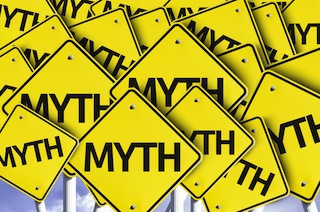 Yesterday’s post introduced the major myths surrounding calories, weight loss, and human regulation of body weight, but there are some other serious misconceptions surrounding the topic that need clearing up. People can really get down on themselves when they listen to all the “experts”. They’ll weigh, measure, and count themselves into oblivion only to experience middling weight loss. Or maybe they lose weight but their energy tanks, their performance in the gym suffers, and their belt size doesn’t get any better, suggesting muscle loss. They’re basing their decisions and actions on myths, and myths just don’t work. These myths do real harm, so it’s important to destroy them.
Yesterday’s post introduced the major myths surrounding calories, weight loss, and human regulation of body weight, but there are some other serious misconceptions surrounding the topic that need clearing up. People can really get down on themselves when they listen to all the “experts”. They’ll weigh, measure, and count themselves into oblivion only to experience middling weight loss. Or maybe they lose weight but their energy tanks, their performance in the gym suffers, and their belt size doesn’t get any better, suggesting muscle loss. They’re basing their decisions and actions on myths, and myths just don’t work. These myths do real harm, so it’s important to destroy them.
Today, I’m going to focus on nine more.
The calorie count of a food is the sole determinant of its metabolic fate.
The way many people envision it, the only thing food does is provide energy for storage or immediate use.
But food is more than energy.
Protein, for example, is broken down into amino acids which provide the building blocks for human cells, muscles, and tissues. And yes, in extreme cases protein can provide energy, either through direct metabolism of the amino acids or conversion into glucose, but the vast majority of the protein we eat is directed toward structural roles. We build things with protein. And even when we do “burn” protein for energy, it’s not very efficient.
Food provides energy and raw material for building important things like muscle, cellular membranes, hormones, nerves, neurotransmitters, sperm, tears, new eyelashes, beards, or toenails. Anything the body does, or makes, or metabolizes, like convert serotonin into melatonin so you can fall asleep at night, requires both energy (to power the process) and raw materials. Food is both.
And even when food is “just” energy, it’s “metabolizable energy.” You have to expend energy to extract energy from that sweet potato and steak you just ate. It’s not gross energy.
Calorie counting is the best way to lose weight.
Since we all agree that weight loss requires that a person expend more energy than they take in, counting them should be the only way to lose weight. Nearly everyone can count and do basic math, so why not just do a little addition and subtraction? Once the stark reality of the numbers lies in front of you and the true, physics-backed path to healthy weight loss reveals itself, you’d have to acquiesce and give in and stop eating so much, you glutton, because Science implores you to and no one can deny Science.
The latest low-fat/low-carb diet study contradicts this: participants in the low-carb arm were told not to restrict calories by the researchers, yet calories were restricted and weight was lost. Detractors often point to this as proof that calories indeed matter. To me, this showcases that active consideration of calories is unnecessary. They lost weight and reduced calories without counting calories. That’s the good stuff, right?
Heck, even when you compare a strict calorie-counting diet with an ad libitum (“at liberty”) low-fat, high-carb diet, the calorie counters lose out and the ad libitum dieters have better weight loss retention after 2 years. Calorie counting just doesn’t work for most people.
At the end of the day, if you consume more calories than you expend, you will gain fat.
Gotta love that phrase, “at the end of the day.” People drop this in comment sections and that’s that: the debate is over, the argument won. Go home.
Except is that really the case? “Weight” is so non-specific. You might gain bone. You might gain muscle. You might gain glycogen. You might gain organ weight. You might gain newly repaired intestinal lining. And yeah, you might gain fat, but it’s not a foregone conclusion just because you “gained weight.”
Conscious regulation of one’s energy intake and expenditure is possible.
Imagine if you had to maintain conscious control over every physiological process in your body. When you walked, you’d say to yourself “step left, step right, step left, step right” all day long or you wouldn’t get anywhere. To provide oxygen to your body, you’d have to remember to breathe in and breathe out every few seconds. An hour or so before bedtime, you’d will your pineal gland to begin secreting melatonin so you could sleep. After eating, you’d have to alternately engage and relax your peristalsis muscles to create the undulation that forces food along the digestive tract. Performing a squat would require conscious orchestration of the contraction of dozens of agonist, antagonist, stabilizer, and synergist muscles at once. Life would get pretty unwieldy, wouldn’t it?
So where do we get the idea that eating – one of the most basic and essential physiological processes – requires constant vigilance and number crunching? What did people do before the concept of a calorie was invented?
In metabolic ward studies where calories are counted for you and food is strictly weighed, measured, and provided by the researchers, calorie counting works pretty well. Subjective feelings of appetite are immaterial when you only have access to the food provided and you can’t leave to get more.
In the real world, calorie counting doesn’t work as well. If a free-living guy is ravenous from counting calories and he drives past a McDonald’s, he has the option of stopping in for a McDouble (they still make those, right?) and fries. If a subject in a metabolic ward study is ravenous from having his calories counted for him and he has a fever dream of Ronald McDonald hand-feeding him fresh french fries, it doesn’t matter because he doesn’t have the option of eating any more food.
Besides, it’s not even possible to do it accurately without direct measurement. A group of normal weight men and women were blinded to one of two treadmill exercise sessions (burning either 200 or 300 calories). After the workout, they were taken to a buffet and told to eat as many calories as they’d just burned exercising. Both groups failed miserably.
First of all, they thought they’d burned way more calories than they actually had. The 200 calorie group guessed they’d burned around 825 calories. The 300 calorie group guessed close to 900 calories.
Second, they ate fewer calories than they estimated, but more than they actually burned. Every estimate they made was inaccurate.
And that was in normal weight individuals, the people who are least likely to have broken metabolisms and dysfunctional satiety mechanisms. If they can’t accurately predict energy intake and expenditure, how is anyone supposed to? According to many researchers, self reports of calorie intake and expenditure are “so poor” that they’re more harmful than not even trying to count.
Everyone responds to calories equally.
For the most part, people all have the same basic physiological machinery. We all metabolize carbs, fat, protein, and other nutrients along the same pathways. We all use insulin to sequester glucose into cells, for example (even people who don’t produce insulin will respond to injected insulin).
That said, we all have different capacities for using these pathways.
For instance, most overweight or obese people seem to do best on lower-carb, higher-fat diets. The literature is pretty clear on that. If you’re insulin-resistant and overweight (which is most of the overweight population), going low-carb is the best, easiest way to control hunger, spontaneously reduce food intake, and lose weight and, most importantly, body fat. Hundreds of success stories from this site and others are further testament to that.
However, the relatively rare insulin-sensitive obese phenotype does better on calorie-counting low-fat diets. If you’re obese and insulin sensitive, you’ll probably be able to lose more weight eating more carbs. That’s just a fact, and it’s just more proof that macronutrient ratios, personal history, hormonal status, and genetic background are relevant to the impact of calories.
Another example: Say you’ve got two men, both weighing 200 pounds and standing 6 feet tall. The first is active, fit, and muscular, sitting at 11% body fat. The second is sedentary and overweight, sitting at 30% body fat. If they eat an equal amount of baked potato, will those carbohydrates enjoy the same fate in both men?
The first guy has significantly more muscle. That means larger glycogen stores, the only way to store carbohydrate. The second guy has significantly less muscle, meaning he has less room to store carbohydrate as glycogen. Assuming both are equally glycogen depleted, in whose body will the greater portion of carbohydrates be sequestered as body fat?
The first guy is more likely to store the carbs as glycogen because his larger muscle mass confers greater storage capacity. The second guy is more likely to convert the carbs to fat. Once his liver and muscle glycogen stores fill up, any glucose that isn’t immediately used for energy will be converted to fat. This isn’t a huge acute contribution to overall fat gain, but it does illustrate the different metabolic fates the same number of calories can have in two different people of equal weight.
And we all know that guy who can eat a 2000 calorie meal without gaining an ounce. If you sit next to him while he eats, you can literally feel the heat emanate from his body. Or maybe he’ll start fidgeting, or get up to pace the room. Kids are often like that. You feed them a big meal and they’ll be whizzing around the room, not to “burn the calories off to avoid weight gain” but because they just received a large influx of energy and it’s only natural for a kid to use it. That used to be me back in college.
Exercise affects appetite and inadvertent calorie intake differently in men and women. In men, the higher the exercise’s intensity, the lower the appetite. This is true across most studies. But there’s also evidence that in women, intense exercise — sprints, HIIT, circuit training — actually has the potential to increase appetite and energy intake.
The only thing that might affect weight loss beyond calories in, calories out are your macronutrient ratios.
This is where we start getting somewhere. Most people will admit that different ratios of macronutrients (protein, fat, carbs) in the diet can affect weight loss. This is why bodybuilding cutting diets are made up of chicken breast and broccoli, not Coke and pizza. But they’ll go no further than talking protein, fat, and carbs.
In reality, different subtypes of protein, carbs, and fat have different metabolic effects. Take protein. Whey promotes energy expenditure relative to other proteins, like tuna, egg, or turkey. Other studies have found that both whey protein and pea protein suppress the appetite to a greater degree than milk protein or a combination of whey and pea protein. Meanwhile, fish protein eaten at lunch suppresses subsequent energy intake more than a beef protein lunch.
Take carbs. In one (rat) study, isocaloric amounts of honey and table sugar had different effects on bodyweight. The rats who ate honey gained less bodyweight and body fat (particularly that really hard-to-burn epididymal pad fat we all hate so much!) than the sugar-fed rats.
Take fat. In one study, isocaloric amounts of either industrial (not grass-fed ruminant) trans-fat or a blend of monounsaturated and saturated fat were given to human subjects. Those eating the trans-fat experienced greater increases in body fat and waist circumference. There was no difference in overall bodyweight, of course, so I guess the CICO fanatics “win” this one, but the two different fat sources clearly had different metabolic fates.
There are more examples of each, but even just one is enough to dismantle the claim.
The results from studies apply to every individual human.
Lost in all the blog chatter about this or that study is the fact that the faceless participants whose bodies we’re discussing are individuals. The individual experiences of these individual subjects dissolve into the mean, the average presented in the abstract. If you’re lucky, you’ll get a +/- indicating the range of responses. But every subject from every study ever conducted has had unique reactions to the experiment.
For instance, there’s the “single low-calorie subject” from this study who experienced no reduction in liver fat. Everyone but him saw improvements. Should that guy disregard his own experience because the study’s conclusion about the effect of dieting on liver fat in the “average person” said otherwise?
You are not a statistic. This goes for every study out there, but it’s especially pertinent for diet studies. I know many people who’ve had paradoxical responses to various dietary interventions, responses that the studies don’t really capture. Are they all lying?
The concept of a calorie isn’t applicable to the complexity of human metabolism.
Sometimes, I like to dream that we’re bomb calorimeters.
Our stomachs are buckets full of water (that’s where those “the human body is 75% water” claims originate). Suspended inside those stomach buckets is a smaller sack, called a bomb. A tube runs from our mouths and feeds directly into the bomb. When we eat something, the food goes down the tube and into the bomb. As we chew, a series of tendons attached to our jaws rub together to produce a spark. The heat travels down into the bomb to ignite the food. A separate tube runs from our lungs to the bomb carrying pure filtrated oxygen. The food combusts and the heat generated is distributed throughout the body to give us energy. The beauty of digesting our food in the bomb is that it’s a closed system, shut off and free of influence from the outside universe, so we know that what we put into the bomb is exactly what we’ll get out of digesting it. Meat, potatoes, kale, Pepsi – it’s all pure unadulterated raw fuel and it all burns equally. It’s all heat energy.
Unfortunately, that’s not how the human body works.
The scientists all agree that a calorie is a calorie.
I contend that no one truly believes “a calorie is a calorie.” Even the researchers who claim perfect parity between different caloric sources in esteemed scientific journals contradict themselves in their own papers.
We conclude that a calorie is a calorie. From a purely thermodynamic point of view, this is clear because the human body or, indeed, any living organism cannot create or destroy energy but can only convert energy from one form to another.
No argument here.
In comparing energy balance between dietary treatments, however, it must be remembered that the units of dietary energy are metabolizable energy and not gross energy. This is perhaps unfortunate because metabolizable energy is much more difficult to determine than is gross energy, because the Atwater factors used in calculating metabolizable energy are not exact. As such, our food tables are not perfect, and small errors are associated with their use.
“Small errors.” Mistakes were made, nothing to see here, move along. Don’t worry yourself over the margins. It all evens out in the end.
In addition, we concede that the substitution of one macronutrient for another has been shown in some studies to have a statistically significant effect on the expenditure half of the energy balance equation. This has been observed most often for high-protein diets. Evidence indicates, however, that the difference in energy expenditure is small and can potentially account for less than one-third of the differences in weight loss that have been reported between high-protein or low-carbohydrate diets and high-carbohydrate or low-fat diets.
It’s just “one third” of the difference in weight loss. That’s nothing at all!
As such, a calorie is a calorie.
Even though we just explained how a calorie is not a calorie, a calorie is a calorie.
Further research is needed to identify the mechanisms that result in greater weight loss with one diet than with another.
In other words, our simplistic “calories in, calories out” approach is inadequate and other mysterious “mechanisms” are responsible for the difference in weight loss between diets. But trust us, a calorie is still a calorie!
We’re all on the same page here. Some of us just can’t admit it.
Thanks for reading, everyone, and let me know what you think in the comment board!



January 7, 2015
7 Common Calorie Myths We Should All Stop Believing
 Many people think weight loss is simply about cutting calories. They believe that to lose weight, you must reduce calories (either eat less or burn more), to gain weight you must add calories, and to maintain weight you keep calories constant. To these folks, calories in, calories out is the only thing that matters. They usually oppose the Primal Blueprint because they assume that we “deny” the importance of calories in weight loss.
Many people think weight loss is simply about cutting calories. They believe that to lose weight, you must reduce calories (either eat less or burn more), to gain weight you must add calories, and to maintain weight you keep calories constant. To these folks, calories in, calories out is the only thing that matters. They usually oppose the Primal Blueprint because they assume that we “deny” the importance of calories in weight loss.
Well, they’re wrong. I don’t deny the importance of calories. Calories absolutely count. And if someone has lost weight, they have necessarily expended more calories than they consumed. That said, there are some major misconceptions about calories, body weight, fat loss, and health. These calorie myths are often rooted in truth but presented in black-or-white terms that are useless at best, harmful at worst, and do little to help the average person lose body fat.
Let’s dig right in.
Calories in, calories out is all you need to know.
Simple is nice. Simple is good. But overly simple is dangerously inaccurate, so let’s break this statement down.
What does “calories in” refer to?
Calories in — what we eat. We can’t metabolize sunlight or oxygen. We can’t feast on the souls of the damned. The food we eat determines “calories in” entirely. Simple.
“Calories out” is where it gets confusing. There are several components to “calories out”:
Resting energy expenditure — the energy used to handle basic, day-to-day physiological functions and maintenance
Thermic effect of food — the energy used to digest food and process nutrients
Active energy expenditure — the energy used during movement (both deliberate activity like lifting weights, jogging, and walking, plus spontaneous activity like shivering and fidgeting)
Not so simple, is it? There are a lot more variables to consider.
Oh, and about those variables…
Calories in and calories out are independent variables.
That would be nice. You could drop energy intake and maintain your resting metabolic rate while burning the same amount of energy digesting food (even though you’re eating less of it) and working out. The fat would melt off at a predictable, constant rate. Anyone with basic arithmetic skills (or a calculator) could become a successful weight loss coach and very few people would be overweight.
In reality, the amount and type of calories we eat affect the amount of energy we expend:
During calorie restriction, the body “defends” its body weight by lowering resting metabolic rate and reducing spontaneous physical activity. To keep weight loss going, you often have to lower food intake even more (to counteract the reduced metabolic rate) and remind yourself to fidget, tap your feet, twiddle your thumbs, and shiver (to recreate the missing spontaneous movement). And you have to do it again when the body readjusts.
Whole foods take more energy to process and digest than processed foods. In one example, subjects either ate a “whole food” sandwich (multigrain bread with cheddar cheese) or a “processed food” sandwich (white bread with cheese product). Both meals were isocaloric (same number of calories) and featured roughly identical macronutrient (protein, fat, carb) ratios. Those eating the multigrain sandwiches expended 137 calories postprandially (after their meal). The white bread group expended only 73 calories, a 50% reduction in the thermic effect of food.
Protein takes more energy to process and digest than other macronutrients. Compared to a low-fat, high-carb diet, a high-protein diet increased postprandial energy expenditure by 100% in healthy young women. And in both obese and lean adults, eating a high-protein meal was far more energetically costly (by almost 3-fold) than eating a high-fat meal.
Calories in affects calories out. The two variables are anything but independent of each other.
Weight gain is caused by eating more calories than you expend.
Calorie fetishists love pointing out that weight gain requires overeating. That is, everyone who gains weight necessarily ate more calories than they expended. Okay. We’ve established that everyone agrees on this. But it’s just restating the issue. It doesn’t tell us anything new or useful. It’s merely descriptive, not explanatory.
To show you what I mean, let’s do the same thing with other phenomena.
Why was Martin Luther King Jr. assassinated? Because someone pointed a sniper rifle at him and fired it.
Why did Usain Bolt win the 100 m final in the Beijing Olympics? Because he crossed the finish line first.
Why is the restaurant so crowded? Because more people entered than left.
These are technically true, but they ignore the ultimate causes. In King’s case, they fail to discuss racism, the civil rights movement, or the motivation of the shooter. They don’t mention Bolt’s training, genetics, or his childhood. They don’t discuss why the restaurant has attracted so many customers — new menu, Valentine’s Day, graduation? They simply restate the original statement using different words. They just describe what happened.
I’m interested in what truly causes us to eat more than we expend and/or expend less than we eat. I don’t care to merely describe weight gain because that doesn’t help anyone.
A calorie is a calorie.
Look. I loved Carl Sagan. Like everyone else, I got chills when he’d wax poetic about our place in the universe and our shared origins as “star-stuff.” But just because steak comes from the same star-stuff as a baked potato, isocaloric amounts of each do not have identical metabolic fates in our bodies when consumed.
We even have a study that examined this. For two weeks, participants either supplemented their diets with isocaloric amounts of candy (mostly sugar) or roasted peanuts (mostly fat and protein). This was added to their regular diet. After two weeks, researchers found that body weight, waist circumference, LDL, and ApoB (a rough measure of LDL particle number) were highest in the candy group, indicating increased fat mass and worsening metabolic health. In the peanut group, basal metabolic rate shot up and neither body weight nor waist size saw any significant increases.
Does this invalidate the relevance of energy balance? Of course not. Since the peanut group’s metabolic rate increased, they expended more calories in response to added calories, thus remaining in balance. But it does elegantly and definitively invalidate the simplistic notion that all calories, especially added calories, are treated equally by the body.
Weight loss and fat loss are the same thing.
People don’t want to lose weight. “Losing weight” is common parlance, but we really want to lose body fat and retain, or gain, muscle. And studies indicate that the macronutrient composition can differentially affect whether the weight lost is fat. It’s not just about total calories.
Take the 2004 study from Volek that placed overweight men and women on one of two diets: a very low-carb ketogenic diet or a low-fat diet. The low-carb group ate more calories but lost more weight and more body fat, especially dangerous abdominal fat.
Or the study from 1989 that placed healthy adult men on high-carb or high-fat diets. Even though the high-carb group lost slightly more body weight, the high-fat group lost slightly more body fat and retained more lean mass.
Just “weight” doesn’t tell us much. What kind of weight? Are we losing/gaining fat or muscle, bone, sinew, organ? Are we increasing the robustness of our colons and the number of bacterial residents (who, though small, carry weight and occupy space) from added prebiotic fiber intake? These factors matter for health. I’d argue that they’re the only factors that actually matter when losing or gaining weight because they offer insight into our health and body composition.
Exercise helps you lose weight only by burning calories.
Most people think of exercise as a way to mechanically combust calories. And that’s true, to a point. Exercise does “burn” calories, and this is a factor in weight loss. But it does lots of other cool things to our physiology that can assist with improving body composition, too.
Compared to something high intensity like burpees or something aerobic like running a 10k, lifting free weights doesn’t burn many calories when you’re lifting them. But it does improve insulin sensitivity, which reduces the amount of insulin we secrete for a given amount of carbohydrate and increases our ability to burn body fat. It increases muscle mass, which uses calories (protein). It strengthens connective tissue, which also uses calories. It even preserves metabolic rate during weight loss and boosts it for up to 72 hours post-workout. All these changes affect the fate of the calories we ingest.
If calories burnt were the most important factor, then the best way to lose weight would be to hammer it out with as much endurance exercise as you can withstand because that’s the most calorie intensive. But studies show that combination training — aerobic and resistance training — leads to greater reductions in body fat than either modality alone.
Even aerobic exercise isn’t just about mechanically burning calories. It also preferentially targets the reward regions of our brains, reducing the allure and spontaneously lowering our intake of junk food.
Counting calories allows us to accurately monitor food intake.
You’d think that, wouldn’t you? Most foods at the grocery store have labels. Even restaurants are beginning to emblazon menus with calorie counts for each item. As humans, we implicitly trust the printed word. It looks so official and authoritative, and it spells out with great specificity exactly how many calories we’re about to eat.
Except studies show that’s not the case. Whether it’s the nutritional information provided by restaurants, the calorie counts on supposedly “low-calorie” foods, or the nutritional labels on packaged foods, calorie counts are rarely accurate. Food manufacturers can even underreport calories by 20% and pass inspection by the FDA.
Maybe that’s why people have so much trouble sticking to their allotted number of calories. If only reality would bend to the will of the label!
You may roll your eyes at some of these ideas because they’re so preposterous, but consider where you’re coming from, where you’re reading this. This is how the general public – and, often, the experts and physicians advising their patients and writing policy — approaches the question of fat loss. Sure, not everyone immersed in conventional wisdom holds every one of these myths to be true. And when they’re actually faced with the statement, few will claim that a calorie of steak is metabolically identical to a calorie of white sugar or that weight loss is the same as fat loss. But when calories in, calories out is the first line of attack against excess body fat, these are the kind of myths that become entrenched.
It’s important to take them head-on.
No one wants to be fat. The obese know they’re obese. They’ve had “calories in, calories out” drummed into their heads for years. If it were really as simple as eating less and moving more, they wouldn’t be obese. And yet here we are. That might be the biggest danger of the continued propagation of these myths — they convince people that they’ve failed at something simple, basic, and central to being a healthy, moral human being.
Thanks for reading, everyone. Take care and be sure to let me know what you think of these calorie myths in the comment section. And check back soon. I’ve got more calorie myths on the way.
Prefer listening to reading? Get an audio recording of this blog post, and subscribe to the Primal Blueprint Podcast on iTunes for instant access to all past, present and future episodes here.



January 6, 2015
20 Ways to Set Yourself Up to Succeed in Your 21-Day Challenge
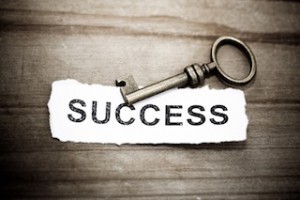 For some people, facing and surmounting a challenge is as simple as just doing it. These are the lucky few who can decide to accomplish something and immediately begin accomplishing it. Want to write a book? They sit down and begin writing. Get the girl? They go up and talk to her. Most people aren’t like this. Most people need tips, tricks, tools, and concrete strategies. They require more than the simple inspiration that lies within to get moving and actively pursue the goal – whatever it may be. And even if that internal motivation exists, the tools and tips can still help activate and enable it.
For some people, facing and surmounting a challenge is as simple as just doing it. These are the lucky few who can decide to accomplish something and immediately begin accomplishing it. Want to write a book? They sit down and begin writing. Get the girl? They go up and talk to her. Most people aren’t like this. Most people need tips, tricks, tools, and concrete strategies. They require more than the simple inspiration that lies within to get moving and actively pursue the goal – whatever it may be. And even if that internal motivation exists, the tools and tips can still help activate and enable it.
That’s why I’ve compiled 20 ways (some of which were originally published in 2013) to set yourself up for success in the impending Primal Blueprint 21-Day Challenge. Because I know that feeling. While I’m lucky enough to do the things I want to do and hardworking enough to often succeed at them, it doesn’t always come easy. There’s a lot that comes before “just doing it.” We all need a little help getting started.
Don’t think you need to employ all 20 strategies, though. In fact, trying to might just overwhelm you and impede your progress. You might need five, six, just one, or even none! Use what works, what’s applicable to your personal struggles, and discard the rest.
General
1. Enlist a friend to join you.
It’s one thing to stay accountable to yourself – not the greatest motivator for some people, because failing to follow through means the only person you’re offending or letting down is yourself. But when failing means failing a trusted, loving friend or relative who has pledged to also complete a challenge at your side, failure hits harder. You know how your folks could always make you feel really bad by saying they “weren’t mad as much as disappointed in you”? Failing a friend is kind of like that. It hurts, and in order to avoid the pain, you’ll probably stick with the challenge.
2. Make your challenge public.
Has anyone watched the mid 2000s HBO show Rome? Ian McNeice played the town crier who would announce news and political developments, basically serving as an expository vehicle to keep viewers up to date on the show’s complex storyline. I’ve got to imagine that he’d also be a great way to hold people accountable for their challenges by letting their social circles in on it. We don’t really have town criers anymore (unfortunately), but we can make our challenges public through Facebook, Twitter, forums, apps, or good ol’ fashioned face to face contact.
3. Reward yourself for incremental successes.
We aren’t dogs, but we do respond to conditioning. Every time you succeed along your journey, give yourself a little reward. Not Hershey’s Kisses, not a cronut, not McDonald’s fries, mind you. Contribute a few bucks to a vacation fund. Watch an episode of your favorite TV show. Take a couple hours to go for a hike. Eat a slice or two of bacon. Reward your animal side with something you enjoy (as long as it doesn’t conflict with the spirit and intent of your challenge, like the aforementioned cronut) to establish a positive association with hard work.
4. Print out a calendar and plan your challenge, day by day.
21 days might seem like a long time, but it’ll go faster than you think. Don’t let it get away from you. Get ahead of it from the very start by planning – meticulously or loosely – your approach for the Challenge. Fill out the calendar today, before it starts, and tick each day off as you complete it – but only if you stick to the schedule! Hey, it worked for Seinfeld.
5. Start with a small win.
Big wins start small. When I’m sitting down to write a book, I don’t measure success by drafts, chapters, or even pages. If I can get a solid paragraph down, I’m happy. That’s a win. It’s not the win (I’m not sure such a thing even exists, to be honest) and it doesn’t mean I’m finished, but it’s a start. As you approach the Challenge, break your goals up into little winnable bites, and then prepare to crush them. And make sure to celebrate those wins. You don’t need to bust out the confetti, but you should acknowledge the small win (and give yourself one of those rewards mentioned earlier).
6. Test your mettle.
During the course of the 21-Day Challenge, your instinct may be to avoid temptation. To avoid eating out at lunch, to skip happy hour with friends, to disconnect your cable, to bow out of that surprise party. And while that kind of diligent avoidance at all costs might work for some, I submit that placing yourself in compromising situations where your personal commitments to the challenge are directly tested will help you rise to the challenge and come out victorious – arguably more victorious than the person who just avoided everything all three weeks. Plus, it’ll prepare you for real Primal life outside of the context of the Challenge, where temptation predominates.
7. Don’t overreach. Focus.
Because the Primal Blueprint is such a holistic, overarching way of life and not just a way of eating, I was torn on this one. Should you guys try to address all the Primal lifestyle factors or just focus on one? I worried that a narrow focus might take away from the power of the PB, which depends in large part on its broad vision. Ultimately, I think a focused approach is the best way to tackle the upcoming Challenge. And anyway, whether your personal journey focuses on Primal eating or sleeping better or moving more or spending more time in nature, by accomplishing any one of those goals the rest of Primal living will tend to fall into place. It’s all designed to work in concert, after all, and it’s hard to deny the rest when one particular aspect feels so right.
8. Start a challenge journal in the MDA forum.
Participating in the PB Journal forum is a powerful way to publicize your challenge (and hold yourself accountable to all the MDA readers), plan your challenge (by immortalizing it in writing), and reward yourself for and acknowledge the small wins (by receiving encouragement from other readers).
9. Approach the challenge with an abundance mindset.
If you haven’t read this post about approaching the Challenge with an abundance mindset, do so now. Long story short, instead of thinking about the “deprivation” of giving up foods and behaviors and habits you’ve grown accustomed to, imagine the beneficial changes you’ll be making. Stop fretting over the food you won’t be eating and imagine all the delicious and nutritious food the Challenge will inspire you to eat. Don’t think of how unpleasant the workouts will be; imagine the energy and strength and vitality you’ll feel as you incorporate regular physical activity into your life. Don’t imagine how hard going Primal will be. Think of how good you’ll feel.
10. Download the 21-Day Challenge app.
All those recommendations I just mentioned in the previous nine entries are built-in to the Challenge app. If you want a community of people to compare journeys and track progress, get the app. If you want daily challenges that test your mettle, get the app. If you want to focus on specific goals, use the app to drill down on what really matters to you. If you want small wins that lead to big wins, you’ll see them immortalized in the app. If you need a calendar, the app breaks the entire challenge down, day by day. If you want to make your challenge public, there’s a whole community waiting to see what you’re made of. And if you want to invite friends, that’s a feature of the app. It’s free, so why not sign up? Just be sure to join the app Challenge by Jan. 12th. Joining mid-Challenge is prohibited.
Eat
11. Get a Primal cookbook.
If you’re the type to whip up fantastic meals without measuring or reading anything, disregard this tip. Then again, if that describes you, you’ve probably got this Primal eating thing down pat and your personal challenge has nothing to do with food. For the more hesitant among us, a Primal cookbook provides a culinary roadmap as we navigate the challenge. A cookbook won’t tell you what and when to eat, but it is a helpful resource that removes additional guesswork and allows you to focus on what and when you should be eating to succeed. Alternately, check out Primal recipe aggregators like Foodee or Chowstalker.
12. Track your food intake.
Not your calorie intake. Your food intake. Write down all the amazing meats, vegetables, fish, fruit, seeds, nuts, and fats you’ve been eating. Research suggests that the simple act of writing down what you eat can speed up weight loss and promote better food choices by forcing you to confront – in plain writing – what you’ve been eating. And even if your personal challenge won’t be about losing weight, seeing the cool stuff you’re encouraged to eat throughout this challenge will inspire and motivate you to keep eating the right way. Mind you, I’m not suggestion you write down everything you eat forever, just that it can be a useful exercise in the short term. Like, say, 21 days or so?
Move
13. Get new workout clothes.
I’ll admit that I’m a gear fiend. I love having the latest Vibrams, the best standup paddle board, the high tech moisture wicking hiking shirts, and so on. It makes me want to get out and move. I know I don’t need that stuff to be active and fit, but it certainly doesn’t hurt and it seems to help. So go on – grab that Lycra bodysuit you eye every time you’re in the mall. Outfit yourself in neon spandex. Stock up on Karate Kid headbands. Bring back leg-warmers. Buy whatever it takes to get you motivated to move.
14. Without thinking too hard about it, commit to and pay in full for a fitness course you’ve been eying.
Right this instant, click over to that MovNat workshop, PRIMALity playshop, yoga class, CrossFit beginner class, Olympic lifting workshop, Fitwall session, or any other fitness-related course or class that you’ve been considering for awhile and sign up. Quickly, before you get cold feet and back out. The Challenge is coming soon and you need to commit to something.
15. Get a movement tracker.
My rule of thumb is “three to five hours of dedicated slow moving per week” at a bare minimum, with even more being better, because when you also include the trivial movements we do around our houses, to and from the car, while shopping, and so on, it usually adds up to 10,000 steps a day. Counting hours is easier to track than counting steps in your head or calculating distance – unless you get a movement tracker like a FitBit or a Jawbone or a free pedometer app. These devices allow greater precision when tracking your progress. Going fast and loose is usually good enough as long as you’re Primal, but knowing exactly how much you’re moving can be extremely motivating.
16. Join Fitocracy.
Fitocracy turns exercise into a role playing game with points, level-ups, and social acclaim, transforming even the most grueling workout regimen into an opportunity for play. With over a million users, they must be doing something right. Sign up and start playing. Get your account ready before the Challenge begins.
17. Peruse Craigslist for used fitness equipment.
Craigslist is a treasure trove of misfit kettlebells, barbells, bumper plates, power racks, weight vests, Schwinn Airdynes, bicycles, surf boards, snowboards, and weight benches. Whether you plan on pledging to lift heavy things more frequently or integrate fitness into your daily life or even just take up a new sport, you will find something fun and relevant to play with and get you moving on Craigslist. Get on and get inspired without breaking the bank.
Other Stuff
18. Get a sleep tracker.
Sleep-focused challenges generally boil down to “get more and better sleep.” Beyond just going to bed at a reasonable time, limiting (or mitigating) artificial light at night, and doing all the other standard Primal sleep techniques, the sleep tracker might be a difference maker in such a challenge. Sleep tracker apps and devices monitor your movement during the night and use the data to evaluate the quality of your sleep so you can figure out what’s working, what isn’t, and what might be causing the poor (or good) sleep. Check this top five list of trackers for a lead on the more promising options, and note that both the FitBit and Jawbone movement trackers do sleep tracking, too.
And finally:
19. Create a “Check Mark’s Daily Apple” alarm.
Most of you don’t need this (I see the site metrics!). But just in case you need an extra shot of inspiration, information, or reference materials, set an alarm to remind you to check in at MDA every single day. Words have power, words change lives, and you might just happen across a collection of words arranged just so that provides the kick in the pants you require to close the Challenge out strong.
20. Pick a 21-Day Transformation Package.
These packages were expressly designed to optimize your performance and results throughout the 21-Day Challenge. Optimal isn’t necessary, of course, but it sure is nice. With the introductory Digital Package, you get all the books, recipes, daily email tips, and published content you’ll need to make the changes to your lifestyle and meet the challenges. With the Fuel Package, you get all that stuff plus a bag of Primal Fuel, a Primal Fuel recipe book, and a Primal Fuel blender bottle — everything you need to whip up a quick, nutrient-dense Primal meal on a moment’s notice. And then there’s the Essentials Package, a collection of everything in the Fuel and Digital Packages with bottles of each of my essential supplements included: Vital Omegas, our high-quality fish oil; Primal Calm, our herbal stress-fighting blend; and Vitamin D, the nutrient that almost no one gets enough of.
It’d be great if everyone could simply snap their fingers and overhaul their entire lives in a positive way. That’s never going to happen, because we’re humans. We dither and hesitate and procrastinate and doubt ourselves. And we need to lean on each other sometimes, or use tools to move things along, or trick ourselves into doing the right thing. Hopefully the preceding tips prove useful to you as you approach the Challenge.
Now it’s time for a little preliminary contest:
I’m pretty sure I’ve missed a few tips about preparing for the upcoming Challenge. There’s always something — you know? With that said, I’d like to hear from you guys: Do you have any specific tips for people getting ready to take on the Challenge? Divulge your best tips in the comment section! One comment will be selected at random, and the lucky winner will be the recipient of a free canister of Damage Control Master Formula. This mini-contest ends at midnight tonight.
Thanks for reading, everyone!



January 5, 2015
The Annual Primal Blueprint 21-Day Challenge Begins Next Week! (and Here’s How to Prepare)
 In past years, I’ve waited until the start of the 21-Day Primal Blueprint Challenge to spring it on you. But this year’s different. My team and I have HUGE plans for this year’s Challenge (Jan. 12-Feb. 1) — so huge that I’m giving you a full week to prepare to ensure you can hit the ground running and keep up with everything we have in store for you. Furthermore, we’re introducing a new tool to make your Challenge experience more rewarding. And more social. It’s an app, available for your desktop computer or Apple iOS device, that lets you connect with other Challenge participants, track your progress, and keep yourself motivated. So what do you say? Are you ready to start preparing?
In past years, I’ve waited until the start of the 21-Day Primal Blueprint Challenge to spring it on you. But this year’s different. My team and I have HUGE plans for this year’s Challenge (Jan. 12-Feb. 1) — so huge that I’m giving you a full week to prepare to ensure you can hit the ground running and keep up with everything we have in store for you. Furthermore, we’re introducing a new tool to make your Challenge experience more rewarding. And more social. It’s an app, available for your desktop computer or Apple iOS device, that lets you connect with other Challenge participants, track your progress, and keep yourself motivated. So what do you say? Are you ready to start preparing?
But how? It’s easy.
1. Get the App
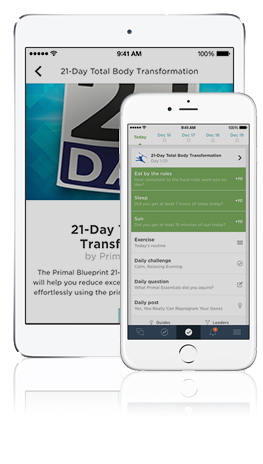 To enrich your experience, we’ve teamed up with Vimify to create a Primal Blueprint 21-Day Transformation Challenge accessible from your desktop computer or iOS-compatible device (iPhone or iPad).
To enrich your experience, we’ve teamed up with Vimify to create a Primal Blueprint 21-Day Transformation Challenge accessible from your desktop computer or iOS-compatible device (iPhone or iPad).
First things first: get the Vimify app and join the 21-Day Challenge. Seriously, go download the app — either to your computer or iPhone/iPad — and sign up right now. It’s free, it takes just a couple minutes, and it will enrich your experience in the weeks to come. (Note: When signing up, make sure you’ve entered your email address correctly and that your password is at least 8 characters long.)
From there, you’ll have a series of Prep Tasks to complete before the Challenge starts on January 12, including:
Purge your pantry of all non-Primal foods and restock it with Primal fare. Doing this now allows you to jump headfirst into the Challenge when it begins.
Do a Primal Essential Movement assessment. Determine your level of physical fitness so you know what you’re working with and can plan fitness goals accordingly.
Invite friends to join you in the Challenge. The strength of this app lies in the community you build, the accountability it promotes, and the healthy competition it provides. You need people to get those benefits.
You can also review the Primal Blueprint Guides to the aspects of Primal living that are especially important to success this Challenge, like the 10 Laws, Shopping Guide, Primal Essential Meals, and the Carb Curve.
After that, it’s a waiting game. Once the Challenge begins, the daily tasks will be linked to the daily challenges, contests, and content posted right here on Mark’s Daily Apple.
Important note: If you want to participate in the app challenge you have to sign up by January 12. There is no joining mid-Challenge. We will be making the app challenge available later this year and on a regular, revolving basis, but there will be a fee associated with future app challenges. Long story short, get in soon!
2. Choose One of the Three 21-Day Transformation Packages
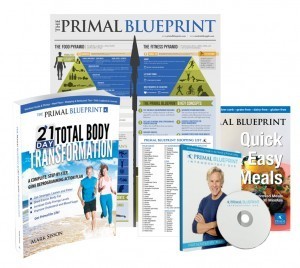 The app is free for everyone. The Challenge is free for everyone. But for those that want to get the most out of the Challenge or could use a little extra guidance, I’ve put together three product packages:
The app is free for everyone. The Challenge is free for everyone. But for those that want to get the most out of the Challenge or could use a little extra guidance, I’ve put together three product packages:
For the Digital Package, you’ll get immediate access to digital versions of the 21-Day Total Body Transformation (the official book of the Challenge), plus an audiobook of the 21-Day Total Body Transformation as well. You’ll also get digital versions of Primal Blueprint Quick & Easy Meals, the Primal Blueprint Poster (a graphic guide to the lifestyle), the Primal Blueprint Shopping List (a complete list of all Primal-approved foods), and an in-depth 90-minute video of me covering all the major elements of the Primal Blueprint lifestyle. You’ll also receive daily email encouragement for the duration of the Challenge, plus access to the app.
The Fuel Package includes all of the above, plus physical versions of the book, the cookbook, the poster, and the shopping list shipped directly to your door. PLUS you’ll receive a bag of Primal Fuel, a Primal Fuel recipe book, and a Primal Fuel blender bottle from which to guzzle all your delicious Fuel creations. It’s the best value of all.
The Essentials Package has everything from the Fuel Package PLUS bottles of Vital Omegas (my high-quality omega-3 fish oil), Primal Calm (my herbal stress-fighting blend), and Vitamin D (because sun is scarce this time of year).
If you have been wondering how the supplements fit into the lifestyle, this is the perfect opportunity to give them a try and see how they work for you. Order today to ensure your package arrives by the time the Challenge begins on the 12th.
Note: The app and the products aren’t necessary to participate in the Mark’s Daily Apple 21-Day Challenge (everyone’s welcome!), but they’ll definitely make your life easier and give you a better shot at success.
3. Get Started on the 2015 Primal Blueprint Recipe Video Contest
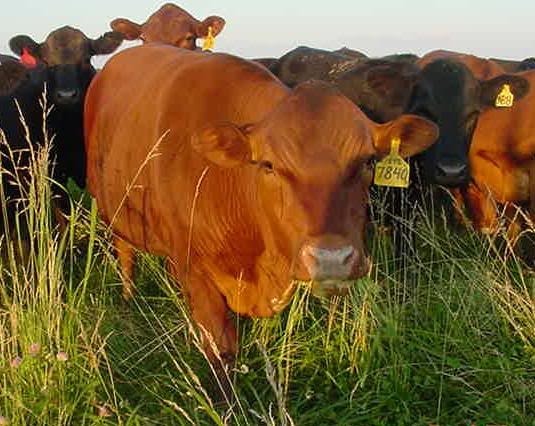 Per annual tradition, once again it’s time to make some delicious Primal dishes.
Per annual tradition, once again it’s time to make some delicious Primal dishes.
The Prize:
US Wellness has long been a favorite meat spot for MDA readers. A few years ago they donated pemmican and the popular 5 gallon bucket of fat. The last several years they’ve gone whole hog. And by hog, I mean cow. And they’re doing it again this year. US Wellness has generously offered up a cow to the winners of this contest.
For those of you with raised eyebrow, they won’t actually be delivering a mooing, cud chewing, udder dangling live cow to your doorstep. But you will receive the delicious meat that once was that cow. And I’m not just talking about a bucket of chuck. The winners will receive sirloin, brisket, short ribs, back ribs, rib-eye steaks, T-bone steaks, NY strip steaks, Delmonico steaks, filets, bottom round roasts, center cut roasts, chuck, tongue, liver, heart, kidney, beef tallow, marrow bones, beef stock, and an oxtail. Heart and tongue not your thing? No worries. This year’s winners will get to choose exactly what they want as they’ll be receiving $1500 worth of US Wellness gift certificates they can use to order hundreds of pounds of their preferred bovine cuts – all grass fed, grass finished. Check out this Grass Fed Goodness video where you can watch your prize/meal grazing around in sweet Missouri pastures.
But winning won’t be easy. It’ll take work. And Primal food…
The Contest:
Create and upload a Primal recipe video to YouTube. Have you mastered the omelet? Are you an organ meat fiend? Maybe your salad is so mean, it can win a chili cookoff. If so, let the world in on your secrets. Grab your video recorder, and show us how to make something Primal. There aren’t really restrictions on how you do it. The only requirement is that your video relates in some way to the Primal Blueprint eating plan. Show the world (how to prepare) your best Primal dish and you could be the winner of a whole bunch of meat. For ideas on what you can do, check out these playlists for recipe videos from 2011 and 2012.
Primal Blueprint Recipe Videos from 2012
Primal Blueprint Recipe Videos from 2013
The Contest Details:
On YouTube, please title the video “Primal Blueprint Recipe:” followed by your own sub-title.
Upload your video to YouTube and then email me the link. Include the words “Recipe Video Submission” in the subject line of your email. Otherwise, there’s a good chance I may completely miss your submission.
The Deadline: Sunday, January 25, midnight PDT.
Who is Eligible:
This one is global, but keep in mind that the US Wellness gift certificates are not available to residents outside the U.S. In the event of a non-U.S. team winning, a prize of equal value will be given as substitute.
How A Winner Will Be Decided:
Video submissions will be posted toward the end of the Challenge. The Worker Bees and I will choose a list of finalists to be voted on by readers.
Fine Print:
MDA reserves the right to publish and/or edit any videos submitted.
We ask that any videos submitted to this contest remain live on YouTube after the challenge for future visitors to Mark’s Daily Apple to enjoy.
4. Tell Your Friends
As I said earlier, the more people we have participating, the more accountability we’ll all have and the better your individual results will be.
I’m really excited about this year’s 21-Day Challenge, and I hope you are, too. See you all on January 12!



January 4, 2015
Weekend Link Love – Edition 329
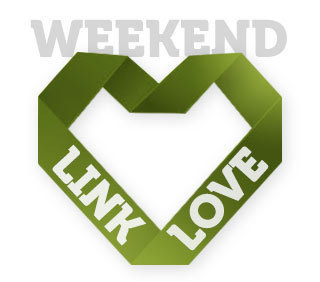 There are only 3 days left to enter to win a free jar of Primal Kitchen™ Mayo! You can enter as many times as you like until the sweepstakes comes to a close. Learn more about Primal mayo and enter at the bottom of this blog post.
There are only 3 days left to enter to win a free jar of Primal Kitchen™ Mayo! You can enter as many times as you like until the sweepstakes comes to a close. Learn more about Primal mayo and enter at the bottom of this blog post.
Are you trying to lose weight? Check out the Unconventional Weight Loss convention, a free online event running from January 4-11, and hear 28 presentations from some of the industry’s leading experts about what could be holding you back. Register today.
Research of the Week
Kids who ate chicken off the bone were subsequently more aggressive, active, and distrustful of authority than kids who ate chicken breast. Yeah, I don’t know either.
An obesity gene only became an obesity gene in people born after 1942.
“Optimized meat products higher in omega-3″ reduce body fat more than “optimized” products lower in overall fat. So, grass-fed beef.
New Primal Blueprint Podcasts
Episode 48: World Speedgolf Champion Rob Hogan: Brad chats with Rob Hogan, the fastest golfer in the world, about bonking, good carbs, and the difficulty of training for this uniquely demanding sport.
Each week, select Mark’s Daily Apple blog posts are prepared as Primal Blueprint Podcasts. Need to catch up on reading, but don’t have the time? Prefer to listen to articles while on the go? Check out the new blog post podcasts below, and subscribe to the Primal Blueprint Podcast here so you never miss an episode.
End of the Year Review: What We Learned in 2014
8 Signs You Probably Don’t Need Any More Protein
How to Gain Weight and Build Muscle
The Definitive Guide to Low Level Aerobic Activity
Interesting Blog Posts
Is social withdrawal the real first line of immune defense for introverts?
Tips for a healthy, active home life.
A condensed history of cholesterol research.
Media, Schmedia
Consider turning down the thermostat. Year round warmth could be making some of us fat.
The Economist investigates why we (think we?) are so busy all the time.
Everything Else
The rise of the super-short workout.
The truth behind the organic egg industry (or, why pastured eggs are still the best choice).
Pagan animism, morning headstands on musk ox hides, and walking the path of love and intent: the rime of a Danish mariner preparing to die (7 minute short film).
Send this video to the people who wonder why you wear orange goggles at night and value sleep so much.
Australians: check out The Paleo Way, a new TV show about, well, you can guess what.
Ex-vegan Big Loser trainer Bob Harper is now fully paleo and gushed about it in a recent interview.
An Australian pro football club has gone paleo.
According to the former editor of the BMJ, cancer is the best way to die.
Genetic modification may allow the return of the American chestnut, a tree that once covered 25% of eastern US forests and provided ample (and delicious) food for people and wildlife until the introduction of Asian chestnut blight wiped them out. What say you?
Recipe Corner
Seared scallops are one of those foods that are ruined by imprecise cooking. They’re expensive, too, so you’d better do them perfectly.
It’s crab season. Go make some crab cakes.
Time Capsule
One year ago (Jan 4 – Jan 10)
17 Reasons to Walk More This Year – These reasons apply to 2015, too.
The Stories We Tell Ourselves – It’s important that our personal narrative is a positive one.
Comment of the Week
If I’m thinking white crystalline substances that cause hypertension, sugar and salt aren’t the only things that spring to mind.
– Hmm, now what could you possibly be referring to?
You CAN Lose Weight and Get Healthy. Find Out How>>


January 3, 2015
Pork Belly and Kimchi Soup
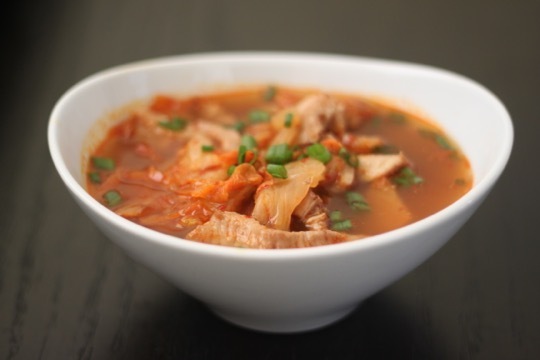 A steaming bowl of pork belly and kimchi soup is like sipping a restorative tonic. It warms you right the core, filling your belly with a good dose of healthy bacteria in a surprisingly delicious way.
A steaming bowl of pork belly and kimchi soup is like sipping a restorative tonic. It warms you right the core, filling your belly with a good dose of healthy bacteria in a surprisingly delicious way.
It’s likely you already know that fermented foods such as kimchi add helpful probiotics to your gut.
If you find the flavor of kimchi to be overwhelming when eaten straight, fear not, it mellows when simmered in soup. A little bit, anyway. It still has a spicy, garlicky kick but in a less aggressive way.
In this soup, kimchi + pork belly + water quickly creates a flavorful and just-spicy-enough broth. A dash of coconut aminos and sesame oil (or a pat of butter) round out the flavor. If you like, crack a raw egg into your finished bowl of pork belly and kimchi soup for a meal that’s even more nourishing.
Servings: 2, with leftovers
Time in the Kitchen: 1 hour
Ingredients:
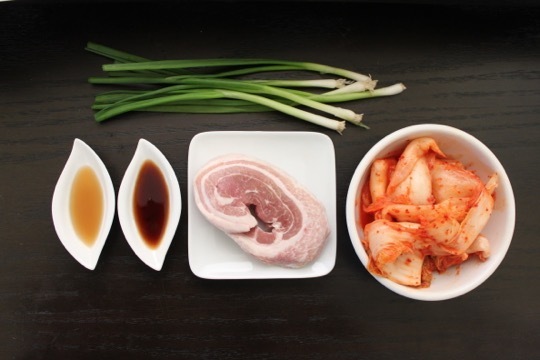
1/3 pound pork belly, sliced thinly and lightly salted (150 g)
2 cups kimchi, chopped (475 ml)
1 cup kimchi liquid, or close to it (240 ml)
6 cups water (1.4 L)
2 teaspoons coconut aminos (10 ml)
2 teaspoons toasted sesame oil or 1 tablespoon butter (10 ml)
4 to 6 scallions, thinly chopped
Optional: A raw egg for each serving
Instructions:
Add pork belly to a large, heavy pot set over medium-high heat. Once fat starts to render off the pork belly (this won’t take long) add the kimchi. Sauté 5 to 8 minutes until it begins to brown around the edges.
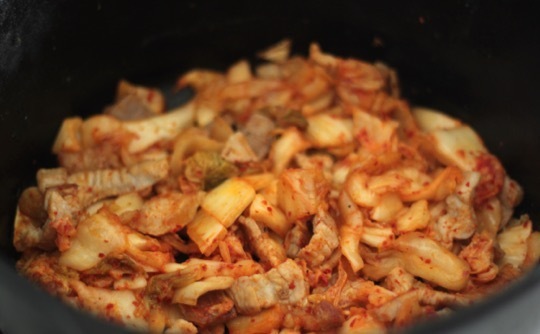
Add the kimchi liquid and water. Bring to a boil, reduce heat and simmer 30 to 40 minutes uncovered.
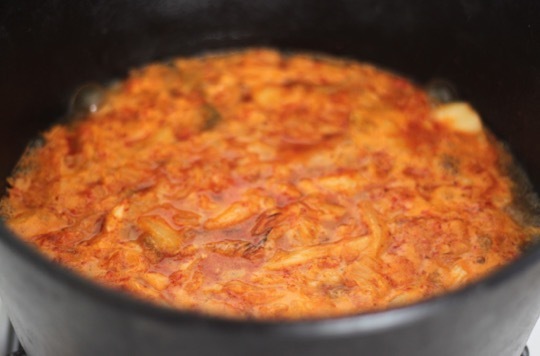
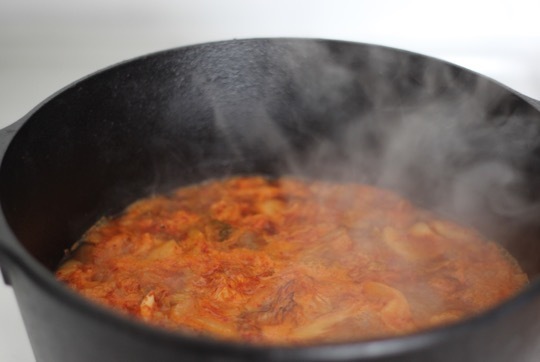
Add coconut aminos and sesame oil or butter. Add salt to taste. Garnish with scallions.
If you like, crack an egg into your hot bowl of soup right before eating.
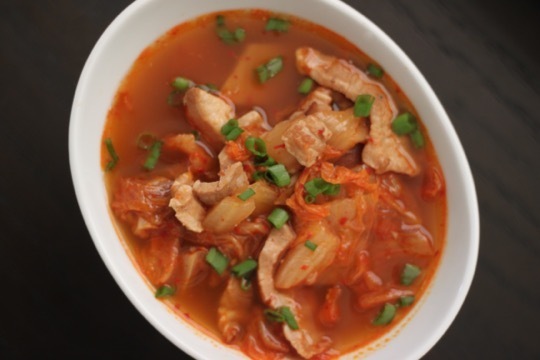
Not Sure What to Eat? Get the Primal Blueprint Meal Plan for Shopping Lists and Recipes Delivered Directly to Your Inbox Each Week


January 2, 2015
From Insanity and Injury to Victory and Health
It’s Friday, everyone! And that means another Primal Blueprint Real Life Story from a Mark’s Daily Apple reader. If you have your own success story and would like to share it with me and the Mark’s Daily Apple community please contact me here. I’ll continue to publish these each Friday as long as they keep coming in. Thank you for reading!
 I always wanted to be an athlete when I was younger. I was an overweight teenager who admired the athletes. I had been a victim of yo-yo dieting and over-exercising (usually running) my whole life. One day—sick of the run/diet/lose weight, stop running/gain weight routine—I decided to pick up running again. But this time I immediately enrolled in a marathon thinking that it would keep me motivated. It did! After my first marathon I was hooked. I became the skinny athlete that I had so longed to be and qualified for the Boston Marathon way too quickly (it was only 10 months after my first marathon and only my 3rd marathon ever). I say “too quickly” because I spent four years of my life proving to myself that the first time was not a fluke.
I always wanted to be an athlete when I was younger. I was an overweight teenager who admired the athletes. I had been a victim of yo-yo dieting and over-exercising (usually running) my whole life. One day—sick of the run/diet/lose weight, stop running/gain weight routine—I decided to pick up running again. But this time I immediately enrolled in a marathon thinking that it would keep me motivated. It did! After my first marathon I was hooked. I became the skinny athlete that I had so longed to be and qualified for the Boston Marathon way too quickly (it was only 10 months after my first marathon and only my 3rd marathon ever). I say “too quickly” because I spent four years of my life proving to myself that the first time was not a fluke.
They say insanity is doing the same thing over and over again expecting a different result. I spent a long five years in the insane asylum. I used to have to take three iron pills a day to battle my anemia from my lack of consumption of red meat in favor of carbohydrates. I had such bad chronic pain in my psoas that I had to go to physical therapy once a week to get a psoas release to keep it at bay. At this time, before I found a decent physical therapist, I was plagued by doctors who had no idea what was wrong. An “expert” at a renowned orthopedic hospital in New York City told me I needed expensive PRP therapy. All of this for what? To earn a Boston jacket that I could flaunt at the grocery store or the next running Expo?
To add to the insanity, I even started dabbling in duathlon (I discovered biking as a way to cross-train while I was dealing with my psoas issues) and had thoughts of completing an Ironman. I spent over 15 hours a week at swimming lessons, biking, running, and strength training and countless hours preparing for it all. Again, I became too good, too quickly. I qualified for Team USA to compete at the World Championships. All of this fed my ego and created an even more self-absorbed person than I already was. Training was always so mentally and physically draining for me. Something was always hurting (c’mon, the rest of you who have yet to go Primal won’t admit it, but something always hurts). I was constantly searching for the next race, creating the next training schedule, researching my competition, and researching the best way to eat and carbohydrate load. It was in the over carbohydrate loading process that I made my first healthy decision in a long time.
You see, I was running the Philadelphia Marathon and I had to stop and DNF (did not finish) half way through. Something was terribly wrong. My legs were throbbing and I couldn’t run one more step. I didn’t go out too quickly and I was running at the pace that I was more than accustomed to running. Looking at my stats later (through Garmin Connect) I noticed my heart rate was pushing 180 (even during my warm-up) when that wasn’t even my 5k heart rate! After a lot of research I came to the conclusion that I had some sort of metabolic breakdown from the extreme carbohydrate loading at over 350 grams in my 107 pound body.
That is when I found Dr. Axe and learned how to eat like my health depended on it. I switched to a Primal [Blueprint] diet (I didn’t realize it at the time) and within three months I blasted my former marathon PR (personal record) and qualified for Boston by 14 minutes. I didn’t get that much better in such a short period of time—it was as simple as changing my diet. I finally realized my dream of qualifying for Boston for the second time in March of 2013 after 18 marathons in five grueling years.
While training for duathlon, I realized that some of my struggle with swimming was my lack of core and back strength. Sorry, runners, you may think running builds your core and overall strength, but it doesn’t. I was weak as hell. So, I joined CrossFit and focused less on running. That had its toll on me as well. It is very hard to go to a CrossFit gym and not over-train. It is designed (although not required) to be competitive, like posting your times on the board and discussing how much you were able to lift. Please understand, I am grateful for the year that I spent there and what it taught me. CrossFit is by nature pretty Primal, but our caveman Grok didn’t post how long it took him to move those rocks or walk to his neighbor’s cave.
My physical therapist believes in the CrossFit philosophies, but warned me of the high risk of acute injury. I poo-poohed him until… I got hurt. I was coming off the rope too quickly so my “team” could post the best time. I jumped off and landed on the rope on the floor and twisted my ankle badly. I was training for the Chicago Marathon at the time (I time-qualified) and refused to listen to the pain. I gave my ankle a “whole three days’ rest” and went out for a run because, by golly, I should be better by now! So, I wrapped my ankle and off I went. Limping, but already two miles into the run, I pulled a Forrest Gump. I just stopped, paused for a millisecond at the thought of what I was about to do and walked back, deciding that the insanity had to stop.
Those were my first Primal steps. What a scary moment that was! After 5 long years, 2,096 activities covering a distance of 14,357.38 miles with a total time of 2,084:27:42 hours, burning up 923,460 calories and 382,710 feet of elevation (Garmin was great for number hungry people like most runners), I was going to end it right there. Stopping a mere 76,540 calories short of a million, I wasn’t even going to run Boston, what this was all about in the first place. I knew that I needed to be active, but I just didn’t know how without tearing myself down. In comes Mark Sisson and The Primal Blueprint. I never looked back.
I am not mentally completely Primal, yet. I have good and bad days. Yes, I am happy with the self-esteem that CrossFit and running gave me, but I sometimes long for the competition and posting my new “age group” medal on the wall. However, I do realize that I am so much healthier inside and out now. My biggest obstacle is the adjustment of looking at a body that is not skinny, but muscular and healthy. I never left for a run without toilet paper in pocket because more often than not I had to ditch into the woods for a potty stop. I now go to the bathroom where I am supposed to! (Poor Grok would not have had this luxury.) For the first time, I feel like nutrition is actually being absorbed in my body and not left in the woods!
I now have a makeshift CrossFit gym in my garage where I exercise, to quote Jay from Mark’s Daily Apple on December 26th, like “I’m slowly letting go of the need to push hard every single time to experience my workouts as joyful expressions of movement, rather than as rungs on a ladder to the next personal record.” I now jog when I feel like it without my Garmin attached to my wrist. (Do you know how long it took me to go out for a jog without going to push a button on my wrist?) I sprint, climb rope, jump on boxes, do pushups, pull ups and walk. How wonderful walking is! Whoda thunkit? Now my biggest worry is carotenosis and explaining to everyone why my hands are orange. I now have energy to clean and do yard work whereas I used to have people that I paid to do that. I had little time or mental ability to concentrate on the things that really matter, like my family or my teaching.
Thank you, Grok. Thank you, Mark Sisson. Eat, sleep and live like a caveman!
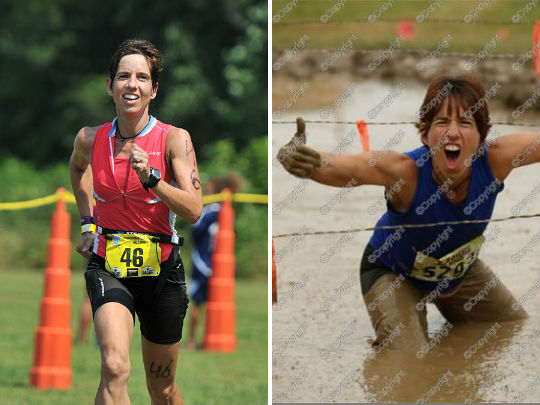
My Primal journey wound up differently that most–with a 20 pound weight gain. My first photo is me, during a half iron duathlon, at 107 pounds. My last race, a zombie run with my son, was 20 pounds later, with more primal fat and muscle than before.
Valerie
You CAN Lose Weight and Get Healthy. Find Out How>>


January 1, 2015
Does 2015 Have Your Name on It? (plus 21-Day Challenge News and a Chance to Win)
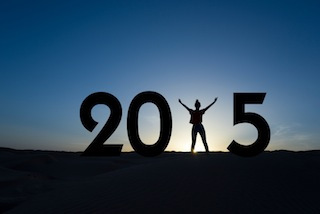 “This is going to be my year!” It’s a common refrain as we change over the calendars every year. And I thoroughly believe each and every one of us should be thinking this exact thought today. As brazen a statement as it might seem, it encapsulates the full possibility and responsibility of owning this year for yourself. The fact is, this year does belong to you. The only requirement is being lucky enough to be alive today. That’s it. If you’re beginning the year in health far poorer than you’d hope, 2015 is just underway. No matter if you have weight to lose, strength to gain, eating habits to change, or stress to be conquered, 2015 is one day in. What could you be doing, feeling and seeing by next New Year’s?
“This is going to be my year!” It’s a common refrain as we change over the calendars every year. And I thoroughly believe each and every one of us should be thinking this exact thought today. As brazen a statement as it might seem, it encapsulates the full possibility and responsibility of owning this year for yourself. The fact is, this year does belong to you. The only requirement is being lucky enough to be alive today. That’s it. If you’re beginning the year in health far poorer than you’d hope, 2015 is just underway. No matter if you have weight to lose, strength to gain, eating habits to change, or stress to be conquered, 2015 is one day in. What could you be doing, feeling and seeing by next New Year’s?
What will you do with this one priceless year?
Let me propose something bold. (Do you expect anything less from me at this point – those of you who’ve been here before?) Today – this year – let’s go for broke….
Going for broke: let yourself imagine what that could mean for you and your life. And no small thinking here! Let’s shoot those limitations down right away. Think creatively, expansively. What would you like to be able to do?
Let me cut into the good self-reflection for a moment and offer a word of caution about framing these visions. So often people say, “I’d love to get back to X,” X being back to 180 pounds, back in some old jeans, back in shape the way they used to be. Used to be. Back. Old. In reality, you’ll never really get back to X, no matter what it is. That’s a good thing.
It’s not about going back. Don’t dwell in past visions. They too often breed unhelpful comparisons and put an artificial “cap” on our success. So many of us go through life with a fixed sense of self. We hold onto a misguided and tightly circumscribed sense of what we’re capable of, what we can look like, what we can enjoy, etc. It’s time to lose those old stories – no matter how great we think they were.
Can we bring ourselves to believe the past wasn’t the pinnacle? Can we fathom for a minute that we can do better and enjoy it more by doing it differently this time? I’d consider myself living proof of that concept, and I can show you thousands of success stories that demonstrate the same. My experience of 60-years-old beats my experience at 30 hands down.
Let’s envision forward. What you can be today is the best possible version of yourself. For this to happen, it’s critical to change your language and mindset. No one here is going backward. Today you know more than ever about real health, and you’re going to use it now to your full unbridled advantage. You’re going to expand your body’s capacity – and your self-concept.
So, how about this instead?
“This year I want to become leaner, healthier, stronger, better than I ever have been. I want to feel a sense of vitality I’ve never experienced in my life.”
So much better, right?
Now let me sweeten the deal….
This year I’ve slated the annual 21-Day Primal Blueprint Challenge for January 12 through February 1. Yes, I’m aligning the massive reader initiative and ambition we see at every Challenge with the fire power of New Year’s resolution time. While there’s never a bad time to reclaim your health and vitality, I just wanted to see what kind of combustion was possible. Consider that a Challenge in itself!
I have no doubt this community will offer an unmatched energy and enthusiasm. As unbelievable as this is to say, I don’t think I’ve ever looked more forward to the Challenge and the surprises it will bring.
On your end, you can expect a whole host of products, contests and other goodies as well as great supporting content – including for the first time ever an accompanying free app for those who register for the Challenge by January 12.
Be sure to check back on Monday for more details – including initial registration. There’s a time urgent piece here. Challenge participants will only be able to join the Challenge app from January 5th to the 12th. Don’t miss out!
Finally, let me offer this encouragement for anyone who’s still straddling the fence or who’s simply new to MDA. You will find everything you need here for each and every one of these 21 days to meet this Challenge. No one goes it alone. Prepare to be offered the tools and information you need to initiate change and to maintain your momentum. Prepare to be inspired by the outstanding support of this community and to be astounded by the extraordinary videos, recipes and strategies other readers will share in the contests, forum and comment boards.
Know that – no matter where your health is at – you can begin this Challenge counting on the faith of others until amazing outcomes can finally convince you of your own inherent capacity and the potential of the Primal Blueprint for better living. Welcome to your year.
I want to know what your self-challenge will be for 2015 and for these upcoming 21 days? Who’s in? What vision will you be working for? Share your thoughts and questions, and I’ll randomly select one winner to receive a free bag of Primal Fuel. (Sweepstakes ends Jan. 2, 2015, 10 am PST.)
Thanks for reading everyone. Happy New Year!



December 31, 2014
End of the Year Review: What We Learned in 2014
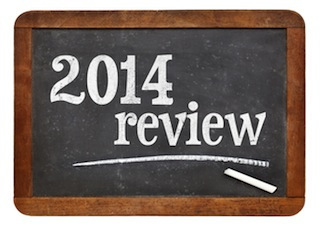 At the dawn of a new year, I like to go back and revisit everything from the past year on the blog. It helps me reflect on the past and plan for the future. 365 posts a year is a lot to remember, and sometimes you need to go back and jog your memory. Then it all comes flooding back. Normally, I do this at home, in my office, in quiet solitude, as a sort of personal ritual. This year, I’ve decided to publish my remembrances.
At the dawn of a new year, I like to go back and revisit everything from the past year on the blog. It helps me reflect on the past and plan for the future. 365 posts a year is a lot to remember, and sometimes you need to go back and jog your memory. Then it all comes flooding back. Normally, I do this at home, in my office, in quiet solitude, as a sort of personal ritual. This year, I’ve decided to publish my remembrances.
2014 has been a big year. Let’s take a look at what we learned and explored together. Where to begin? Well, first…
I took a step back to look at the big picture of human history, addressing the “criticism” that simply won’t die and isn’t even a real criticism of ancestral health: that there was no one single grand overarching paleo diet. Critics love to point this out, as if it destroys the credibility of what we’re doing here. In reality, it strengthens our resolve and our credibility. There’s no one true paleo diet, but so what? Definite trends exist in observed hunter-gatherer and ancestral dietary patterns, we actually do know many foods they ate as staples, and we can learn a lot from studying them. Reality is messy and complicated, without simple answers, and that’s totally okay.
Nutrition was a huge focus. Rather than flail around mindlessly, you learned to watch for the signs you need more carbs, more protein, and more fat. You also learned when not to eat more protein. We revisited the omega-3/omega-6 ratio and questioned our previous stance — was it really as important as we thought? — and we explored the effects of artificial sweeteners on gut health.
As always, food was a major subject on MDA. You discovered the power of medicinal foods, the surprising nutritional content of mushrooms, how to choose a good dark chocolate, plus any potential downsides of dark chocolate. I published a comprehensive guide to buying, cooking, and storing perfect eggs, and I even broke out the old “Is It Primal?” series for a new round of foods. I also explained the potential downsides of processed meat and the advantages of gently cooking your food.
Supplements, too. I gave a comprehensive breakdown of the usefulness (or not) of antioxidant supplements. The myriad benefits of whey protein that have nothing to do with building muscle also got extensive coverage.
We can’t forget gluten. In 2014, together we looked at whether or not gluten is unhealthy in non-celiacs, explored the supposed “dangers” of going gluten-free without a doctor’s note, and researched the connection between gluten and irritable bowel syndrome. Yep, it’s still not very good for you.
You also learned a whole lot about walking this year — more than you thought you didn’t know (that sentence makes sense, I think). You learned the many benefits of walking regularly, both to physical and emotional health, and how to make it more exciting (and sustaining). You even walked with our ancestors as they traversed the globe, exploring the world, shaping the human experience, and setting an example for our greatest thinkers, writers, and artists.
2014 saw us hone in on fitness in a big way. My focus was on helping you find a sustainable plan for physical activity. You figured out how to determine the very best exercise for your body; how to distinguish between movement, exercise, and training; why exercise sometimes feels like a chore or a drag (and what to do about it); and whether or not bodyweight exercises are enough for good strength and fitness. You learned the ten most important rules for successful exercise, why everyone can benefit from a breakthrough workout every now and then, and why you should run a mile. And just in case you needed a little more motivation, I explained what to do when you only want to sit on the couch and just why squatting and sprinting are so important for health and fitness (plus, how to avoid sprinting injuries). For those of you who can’t, or don’t care to squat, we’ve flouted the experts and provided some worthy alternatives. We also explored how fitness is changing “out there,” with top athletes adopting many of the same modalities we’ve been championing for years.
We took a close look at what resistant starch is. We explored who can benefit from it and who can’t. We ran self-experiments to determine the best way to work it into our eating strategies. And, quite frankly, we analyzed the stuff to death and even investigated the paradoxical claim that it increases the risk of colon cancer.
The focus on resistant starch led us to delve more deeply into the wonderfully weird internal world of the gut biome. We explored the things most people never even knew gut bacteria could do, like manufacture steroid hormones and influence our behavior. We also learned about how the things we do and eat in turn affect our gut bacteria. Speaking of the gut, I explained what happens when it gets leaky and how that affects your health, and I provided a few good tips for establishing a healthy gut in your Primal babies. I even talked about the skin biome and learned how to support a healthy one.
Work life balance was a big issue this year. I asked if Grok would have worked overtime and I asked you to really question whether that long commute was worth the trouble, time, and money. In the event that it wasn’t worth it, you learned how and why to telecommute.
I also covered other generally healthy habits, like morning movement sessions. I talked about my decision to give up alcohol for the foreseeable future, even adding some healthy ways to relax and chill out at night that didn’t involve alcohol. I also explored a few alternatives to traditional coffee or tea for waking up in the morning (although if you want coffee, there’s no better thing than a Primal egg coffee frappe).
I asked whether the obesity epidemic is exaggerated and statins are worth the health risks, and wondered if the dietary guidelines are due for a change (they are). I also went over a few signs you aren’t as healthy as you think you are.
We explored our connection to nature (including water), and why severing that connection only leads to unhappiness and poor health. You learned to heed the call of the wild, to acknowledge and cherish your place in the savage world. You learned how sunlight may actually protect you from the worst kind of skin cancer.
Things got a little weird this year, too, with us seriously considering the idea that infectious parasitic worms may actually reduce the incidence of autoimmune disease and regulate our immune systems to work better and that playing video games can actually improve cognition and decision making skills. We welcomed the release of the EXO Bar, a protein bar made from cricket flour, and we learned the proper roadmap for exposing our little ones to dirt, mud, and hopefully non-toxic amounts of animal droppings (just avoid that raccoon poop). You also learned how to manipulate your own neurochemistry using foods, physical activity, and experiences to produce natural (and legal) highs.
2014 saw MDA take a more serious look at the psychological aspects of health. Every Thursday, I turned inward and learned a great deal many truths: a new way to look at affluence, the importance of being thankful for one’s health, the true cost of health, the benefits of being present, the power of a growth mindset, the pros and cons of comparing yourself to others. We explored why we eat (cravings, hunger, and other people) and how to accept our imperfections.
Things aren’t always serious around here. Cheeks have tongue grooves for a reason, getting silly is fun, and satire is oftentimes the best way to get to the heart of a problem. Whether it was learning about the incredible weight loss technology awaiting us in the near future or how to outsource your physical activity to avoid unpleasant sweat, elevated heart rates, and unseemly muscle and fitness gains, I had you covered.
We were lucky enough to have a host of talented guest posters grace us with their knowledge, too. Denise Minger told the story of how she healed the tooth decay caused by her vegan diet (she also wrote a book). Dr. Ron popped his head in to stress the importance of flexibility in health and diet (he wrote a book, too). Bodyweight training master Al Kavadlo gave us a few tips on stretching, Kevin Geary showed us how to liven up our walking, Bethany McDaniel from Primal Pastures told us about the time she killed a chicken and ate it, Michelle Fitzpatrick told us why kids need sun, and Larry Istrail showed us what to take away from crowdsourced ancestral health data.
Every week, delicious recipes were posted to the blog, whetting appetites and fueling family dinners across the community. From snacks like bacon trail mix, cabbage chips, cauliflower muffin bites, and Primal Fuel bars to full-fledged meals like Cuban mojos, lamb meatballs in fenugreek coconut sauce, slow cooker harissa stew, pressure cooker braised short ribs, and chicken vindaloo, 2014 featured some wonderful recipes. Oh, and something called bacon jam exists. It’s as wonderful as you’re imagining.
I can’t forget the Success Stories, which never cease to amaze. Jay overcame overtraining to excel with Primal Blueprint Fitness. Barbie ditched her diabetes medication. Anne-Marie beat Crohn’s. Larry lost 100 pounds, Tim lost 228, Felicia lost 110, and a skeptic was converted. A boy overcame “reverse dysmorphia,” a triathlete made Primal work, and mama successfully retrieved her misplaced sexy. Bob made his passion his business and a pro baseball pitcher improved his game. People have beat terminal illness and injuries. Entire families have made the switch. And those are just a few of them.
Yeah, 2014 was pretty, pretty good. I can’t wait to see what we’ll discover, explore, and learn together in 2015. See you there!
Prefer listening to reading? Get an audio recording of this blog post, and subscribe to the Primal Blueprint Podcast on iTunes for instant access to all past, present and future episodes here.



Mark Sisson's Blog
- Mark Sisson's profile
- 199 followers



